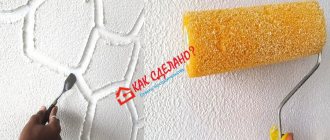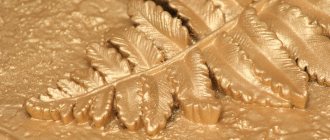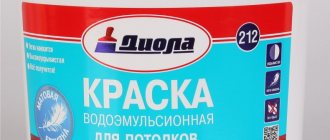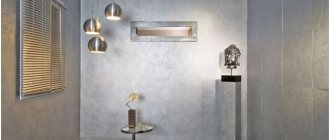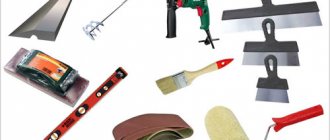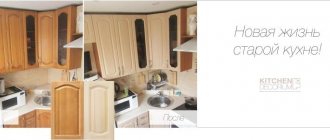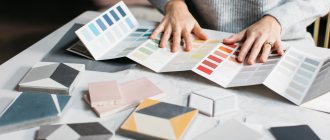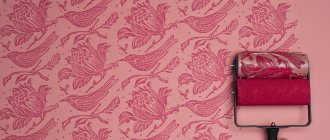The room in which the kitchen is located is rightfully considered one of the most important. This is where food is prepared, guests are received, and the whole family gathers every day. It is essential that the room is functional, safe and aesthetically pleasing. Every housewife is concerned with questions of how and what to paint the walls in the kitchen. The choice of materials for repair work must be approached very carefully. Today, stores are filled with a variety of offers. paint coatings, it is quite difficult to choose the right paint.
Painting a wall with different colors of paint.
What paint to paint the walls in the kitchen
Choosing paint for painting walls.
Deciding which composition is ideal and how to apply it, choosing color and texture - these are the most important questions that every housewife asks when starting a kitchen renovation.
Choosing the texture and color of paint for the kitchen.
All surfaces in the kitchen, such as walls, tiles, furniture and floors, should be easy to clean from dirt, resistant to wet cleaning and temperature changes, resistant to fungus and mold, and at the same time look attractive. A good mood for the whole day is guaranteed if you have breakfast in an ideal kitchen.
Advantages of coatings
An excellent choice for the kitchen is washable paint.
Designers have been using paint and varnish materials when decorating for quite some time now, instead of standard wallpaper, tiles or panels.
Why is paint preferable for decorating kitchen walls? The answer to this question is quite simple. The widest palette and the ability to mix tones allows you to choose absolutely any shade. Practicality, low cost, ease of care and application make paint and varnish materials indispensable for designers. Housewives value them for their excellent moisture resistance, wear resistance, resistance to various mechanical influences and the ease of changing the interior.
Preparatory work
Preparation should begin with a thorough cleaning of the walls. It is necessary to remove everything that may fall off along with the paint or remain under the coating layer, creating an undesirable relief. The last stage is cleaning the walls with sandpaper and removing dust with a damp cloth. After this, the wall is inspected, identifying problem areas (chips, cracks, etc.).
Having prepared the walls, you need to measure the length and width of each wall and calculate the total surface area to be painted. This will help you purchase the right amount of paint. It is better to purchase all materials with a small reserve so as not to be faced with the need to stop work. In addition, it will be difficult to buy again exactly the same paint as the one purchased the first time.
The purchased paint must be tested. You need to apply a few strokes to the wall and wait for it to dry. This test will help ensure that the shade of the painted panels will be exactly the color you chose.
Furniture is being taken out of the kitchen. Anything that cannot be removed is carefully covered with plastic wrap or old newspapers.
Choice of colors
Choosing paint colors for the kitchen, color palette.
To decide what to paint the walls in the kitchen with, it is important to understand what the room will be used for most often and what mood it should convey.
For example, red color in the interior increases appetite and blood pressure, and also causes discomfort when staying in such a room for a long time. Designers use this color with caution when decorating kitchens.
Kitchen design with red walls.
The orange tint lifts the mood and increases vigor, but in excessive quantities it can irritate the optic nerves.
Kitchen design in warm colors, orange walls.
If you often host family dinners or tea parties, then yellow in the interior is your assistant. It calms and improves the gastrointestinal tract. And dark green , purple and gray colors reduce appetite. Pure white evokes an association with a hospital, and the blue color conceals the space.
It is not at all necessary to paint the walls with just one paint. You can highlight the cooking area or separate the dining group, draw stripes or geometric shapes on the surface.
Separation of kitchen zones using color.
The color scheme should be in harmony with the kitchen set and your mood, that is, it should fit into the kitchen design. After all, the walls in the kitchen can be repainted over time. This is not as important as choosing the color of the walls in the children's room.
Types of compositions
Classic kitchen in yellow.
Manufacturers suggest using the following when painting walls:
- Water-based paints , which are a type of water-dispersion composition. They are characterized by the absence of odor, environmental friendliness, the ability to dry quickly and “breathe”. Stains that get on a kitchen wall painted with this composition can be easily removed with a regular rag.
- Alkyd - they smell bad, do not “breathe”, dry very quickly, do not crack and have a high degree of elasticity. They are highly flammable.
- Acrylate is one of the most expensive paint options. It is a mixture of acrylic and latex compounds, characterized by wear resistance and durability. It does not fade in the sun and is not deformed.
- Silicone - relatively recently appeared on the market, are quite expensive and are used for painting plastered textured walls. This is a new generation composition that meets all the requirements for interior paints.
- Latex - do not allow moisture to pass through, dry quickly, forming a protective crystalline film on the surface. They belong to the class of washable interior paints, which are not afraid of chemical detergents.
- Acrylic paints for the kitchen have a wide range of colors, are odorless and dry quickly. When applied, a special film is formed on the surface, which protects the painted wall from abrasion. The color is bright, with a pleasant matte and silky texture.
Painted walls in the kitchen with water-based paint.
Painting the walls in the kitchen with acrylic paint. Some brands offer a variety of decorative compositions that differ in texture, metallic tint or ability to glow in the dark. Some types of dyes imitate the texture of brick or wood. Such paints are environmentally friendly, easy to clean, do not absorb dust and have a high level of wear resistance.
Textured painting of walls in the kitchen using paint.
The assortment of almost any hardware store includes glossy, matte and semi-gloss coatings. Painting kitchen walls with glossy compounds should be done on a perfectly flat surface without rough edges or dents. Any defect will be noticeable. It is worth remembering that a reflective surface visually enlarges the room and hides small spots of dirt. But on a matte finish, on the contrary, any stain will be clearly visible.
Glossy paint for painting walls in the kitchen.
Painting the walls in the kitchen should be done with a composition that is highly moisture-resistant and wear-resistant . The kitchen is a real military training ground for dyes: temperature changes, condensation, grease flying during cooking, and dirt stains. If a painted wall cannot be cleaned of debris and dust, then such a surface will quickly become unusable. The composition must contain elements that prevent the appearance of fungus and mold.
Kitchen design in ethnic style.
The paint should be easy to work with. A parameter such as hiding power is responsible for this. The composition and distinctive characteristics are always indicated on the packaging.
Choosing washable paint
An example of washable paints for painting walls in the kitchen.
Everyone decides for themselves what paint to paint the walls in the kitchen. Water-based paints are great for this. You can also use any polymer compositions, with the exception of PVA-based dyes. This paint is not resistant to moisture and is only suitable for dry surfaces.
The walls in the kitchen are painted and washable.
Silicone, latex and acrylic kitchen paints are also very popular due to their properties and cost. Don't skimp on the choice of paint. Make the right choice of paint for the walls; the lifespan of the entire room depends on its quality and characteristics.
Reviews
Here we have collected several reviews about the use of textured paint.
We hope you found the article interesting.
How to prepare walls for painting
Preparing walls, leveling, in the kitchen for painting.
Painting kitchen walls must be done on a perfectly smooth and even surface. First, you need to remove all stains, traces of dirt and grease, soot, old wallpaper, tiles and other materials. Any crumbling plaster must also be removed.
Fungus and mold, if present, are removed mechanically. The surface in this place is treated with special antibacterial compounds. Potholes are covered with cement or gypsum-based plaster.
Applying paint to decorative putty for kitchen decoration.
The walls are leveled using plaster or moisture-resistant acrylic putty, applied in two or three layers. To increase adhesive properties, primer is applied after each layer.
A deep penetration primer is preferable. It is not expensive and can be diluted with water 1:1
It is recommended to choose moisture-resistant putty from the same company as the paint, because their compatibility will determine how long the paint will dry, the appearance and strength of the coating, resistance to various damages and resistance to wet cleaning.
Creating a design in the kitchen with your own hands, painting the walls.
To obtain an ideal surface, the dried final layer must be sanded.
What it is?
So, what are texture paints?
This material creates or imitates a relief surface. Essentially, the technique of applying decorative paint lies somewhere between decorative plaster and ordinary paint (especially when it comes to creating texture). Differences from standard paint:
- Consistency. The decorative coating is thicker, somewhat reminiscent of very thick sour cream.
- Composition. In addition to the base and pigments, filler particles are used in production, which are responsible for volume.
- Large expense. The layer of textured dye can reach up to 15 mm, while the usual one is 2-3 mm.
Differences from decorative plaster:
- Application thickness. A thinner layer of paint is required.
- Consumption. Due to the reduction of the layer, the material consumption will naturally be less.
- Textured paints for interior decoration can create standard plaster effects (bark beetle, fur coat, lamb), or imitate marble, velvet, leather, silk, embossed paper.
In the photo there is “crumpled” volumetric paint
How to paint the walls in the kitchen
Modern design in the kitchen.
The first step is to prepare everything that may be required in the process:
- Work clothes that you won’t mind throwing away and protective equipment (goggles, respirator)
- Solvents and wipes for cleaning hands and tissues
- Specialized tools: brushes, rollers, masking tape, paint container
- Kitchen wall paint
To begin with, it is recommended to use a medium-sized brush to go through all the corners, hard-to-reach places and the perimeter of the baseboards, then apply the composition to the entire surface with a wide brush or roller.
Work is carried out from top to bottom from the ceiling. Using masking tape, seal the ceiling in the places where it connects to the wall. This allows you to prevent the paint composition from getting onto undesirable surfaces and create an even color.
The quality of the coloring also directly depends on the quality of the roller. Experts recommend using a mohair roller to paint the kitchen area.
Painting kitchen walls with a mohair roller.
It is best to do strokes simultaneously in different directions: from right to left and from top to bottom. Shading will help distribute the paint on the surface as evenly as possible, preventing the appearance of streaks and streaks.
Water-based paints are applied using a W-shaped motion. Then soft vertical and horizontal strokes alternate from the ceiling to the floor. If you plan to apply the substance in two layers, then the sequence should be the first layer vertical, the second horizontal. If in three, then vertical-horizontal-vertical. At the same time, water-dispersed compositions do not require complete drying to apply subsequent layers.
Painting walls with a roller yourself is a very labor-intensive process. The composition must be evenly distributed over the entire surface, carefully rolling it out. Air bubbles and debris falling onto the painted layer must be removed mechanically.
Required materials and tools
In addition to paint and varnish materials (primer, paint, varnish) you will need:
- Application means: brushes, rollers, sprayers, etc. Make sure that the purchased paint can be applied with the tool you have chosen (the list of application tools is contained in the instructions on the package).
- Solvent and rags for removing paint drips from surfaces that will not be painted
- Trays for rollers, containers for mixing and tinting.
Having prepared everything you need, get to work.
Safety
Minimal protection when painting walls.
When carrying out paint and varnish work with your own hands, you need to follow the simplest rules:
- Be sure to wear safety glasses and rubber gloves to prevent dye from getting on your skin and mucous membranes. Hair is hidden under a headdress.
- Use only serviceable, stable ladders and stands.
- The air in the room should flow freely at all times. But you should not allow drafts to form.
Painting the walls in the kitchen with your own hands is a complex but very interesting process. The final result directly depends on the efforts you put in and the patience you show.
Brief conclusions
- Textured paints open up new horizons for creativity.
- The coatings are strong and durable.
- If you wish, you can create a unique effect with your own hands using a minimum of tools.
Sources
- https://design-homes.ru/stroitelstvo-i-remont/fakturnaya-kraska
- https://happymodern.ru/fakturnaya-kraska-dlya-sten-foto/
- https://homius.ru/osobennosti-primeneniya-fakturnoy-kraski-dlya-vnutrenney-i-naruzhnoy-otdelki-sten.html
- https://HouseChief.ru/fakturnaya-kraska-dlya-sten.html
- https://KakSdelatSvoimiRukami.ru/fakturnaya-kraska-dlya-sten-osobennosti-vybora-i-naneseniya/
- https://DekorShtukaturka.ru/dekorativnaya-shtukaturka/nanesenie-fakturnoy-kraski
- https://remontstroimat.com/kak-nanosit-fakturnuyu-krasku-na-steny-i-potolok-pravilno-i-bystro/
- https://ProDekorSten.com/kraska/fakturnaya-kraska.html
- https://stroychik.ru/steny/fakturnaya-kraska
Gallery: Kitchen wall painting design
There are no similar articles.



